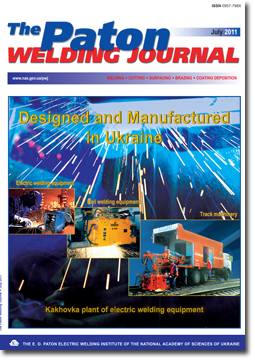| 2011 №07 (05) | 2011 №07 (07) |

The Paton Welding Journal, 2011, #7, 26-29 pages
137Cs AND 90Sr PHASE TRANSITIONS IN SURFACING OF RADIOACTIVELY CONTAMINATED METAL STRUCTURES
A.A. ENNAN1, S.A. KIRO1, M.V. OPRYA1, V.E. KHAN2, B.I. OGORODNIKOV2, V.A. KRASNOV2, A. de MEYER-VOROBETS3, L. DARCHUK3 and B. HOREMENCE3
1Physical-Chemical Institute for Environmental and Human Protection, NASU, Odessa, Ukraine
2Institute for Problems of Nuclear Power Plants Safety, NASU, Chernobyl, Ukraine
3University of Antwerp, Antwerp, Belgium
Abstract
The paper presents the results of investigation of phase transitions of 137Cs and 90Sr radionuclides from the surface of contaminated metal structures into the solid component of welding aerosol (SCWA), slag crust and deposited metal in metal surfacing with stick electrodes. It is shown that SCWA radioactivity is due to adsorption of thermolysis products of Cs2CO3 (Cs2O, Cs2O2, Cs), slag (its contamination by 90Sr and 137Cs), deposited metal surface (formation of cesium monoferrite (CsFeO2) and/or polyferrites (Cs2O.6Fe2O3 and CsFe11O17)). The established empirical dependence of specific activity of 137Cs in SCWA composition on 137Cs surface activity can be used in forecasting the radioactive contamination or air in the working zone and rating the need for personal protective gear for respiratory organs.
Keywords: arc surfacing, radioactively contaminated metal structures, welding aerosol, slag crust, deposited metal, activity of 137Cs, 90Sr radionuclides, phase transitions, object «Ukrytie»
Received: ??.??.??
Published: 28.07.11
References
1. Ogorodnikov, B.I., Pazukhin, E.M., Klyuchnikov, A.A. (2008) Radioactive aerosols of the object «Ukrytie»: 1986-2006. Chernobyl: IPB AES NANU.
2. Pokhodnya, I.K., Gorpenyuk, V.N., Milichenko, S.S. et al. (1990) Metallurgy of arc welding. Processes in arc and fusion of electrodes. Kiev: Naukova Dumka.
3. Ennan, A.A. (2002) Physico-chemical principles of recovery, neutralizing and recycling of welding aerosols. In: Proc. of 1st Int. Sci.-Pract. Conf. on Protection of Environment, Health, Safety in Welding Production (Odessa, 11-13 Sept. 2002). Odessa: Astroprint, 10-37.
4. Plyushchev, V.E., Stepin, B.D. (1970) Chemistry and technology of lithium, rubidium and cesium joints. Moscow: Khimiya.
5. Zimmer, A.T., Biswas, P. (2001) Characterization of the aerosols resulting from arc welding processes. J. Aerosol Sci., 32(8), 993-1008.
6. Jenkins, N.T., Pierce, W.M.G., Eagar, T.W. (2005) Particle size distribution of gas metal and flux-cored arc welding fumes. Welding J., 84(10), 156-163.
7. Sowards, J.W., Lippold, J.C., Dickinson, D.W. et al. (2008) Characterization of welding fume from SMAW electrodes. Welding Res., 81(4), 106-112.
8. Ennan, A.A., Oprya, M.V., Kiro, S.A. et al. (2010) About composition of inhalation particles of welding aerosol. In: Proc. of 24th Sci. Conf. of CIS Countries on Dispersion Systems. Odessa: Astroprint, 327-330.
9. Pokhodnya, I.K. (1972) Gases in welds. Moscow: Mashinostroenie.
10. Erokhin, A.A. (1973) Principles of fusion welding. Physicochemical laws. Moscow: Mashinostroenie.
11. Frolov, V.V., Volchenko, V.N., Yampolsky, M.V. et al. (1988) Theory of welding processes. Moscow: Vysshaya Shkola.
12. Kachalov, D.V., Stepanov, E.G., Kotelnikov, G.R. (2008) Investigation of processes of formation of catalytically active ferrites of alkaline metals. Izvestiya Vuzov. Khimiya i Khimich. Tekhnologiya, 51(7), 45-47.
13. Randhawa, B.S. (1995) Mossbauer study on thermal decomposition of cesium tris(oxalato)ferrate(III) dehydrate. J. Radioanalytical and Nuclear Chemistry, Letters, 201(1), 57-63.
Suggested Citation
A.A. ENNAN1, S.A. KIRO1, M.V. OPRYA1, V.E. KHAN2, B.I. OGORODNIKOV2, V.A. KRASNOV2, A. de MEYER-VOROBETS3, L. DARCHUK3 and B. HOREMENCE3 (2011) 137Cs AND 90Sr PHASE TRANSITIONS IN SURFACING OF RADIOACTIVELY CONTAMINATED METAL STRUCTURES. The Paton Welding J., 07, 26-29.The cost of subscription/purchase order journals or individual articles
| Journal/Currency | Annual Set | 1 issue printed |
1 issue |
one article |
| TPWJ/USD | 384 $ | 32 $ | 26 $ | 13 $ |
| TPWJ/EUR | 348 € | 29 € | 24 € | 12 € |
| TPWJ/UAH | 7200 UAH | 600 UAH | 600 UAH | 280 UAH |
| AS/UAH | 1800 UAH | 300 UAH | 300 UAH | 150 UAH |
| AS/USD | 192 $ | 32 $ | 26 $ | 13 $ |
| AS/EUR | 180 € | 30 € | 25 € | 12 € |
| SEM/UAH | 1200 UAH | 300 UAH | 300 UAH | 150 UAH |
| SEM/USD | 128 $ | 32 $ | 26 $ | 13 $ |
| SEM/EUR | 120 € | 30 € | 25 € | 12 € |
| TDNK/UAH | 1200 UAH | 300 UAH | 300 UAH | 150 UAH |
| TDNK/USD | 128 $ | 32 $ | 26 $ | 13 $ |
| TDNK/EUR | 120 € | 30 € | 25 € | 15 € |
AS = «Automatic Welding» - 6 issues per year;
TPWJ = «PATON WELDING JOURNAL» - 12 issues per year;
SEM = «Electrometallurgy Today» - 4 issues per year;
TDNK = «Technical Diagnostics and Non-Destructive Testing» - 4 issues per year.


